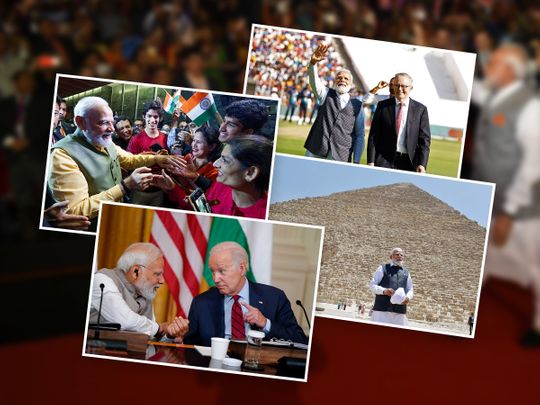
In his nine years in office as India’s Prime Minister, Narendra Modi has made an astounding 121 foreign visits to sixty-five countries.
This figure is notwithstanding the total wipeout of all travel from the second half of November 2019 till the latter part of March 2021 during the worst of the Covid19 pandemic. Compare this with Dr Manmohan Singh, his predecessor, who made 73 trips abroad during his 10 years as India’s two-term prime minister.
Before we consider the larger implications of these visits to India’s foreign policy, we might ask which is the least — and most visited — of all countries on Modi’s itineraries.
No prizes for guessing the latter. The United States, with eight trips of which the last one, from June 20-23rd was a state visit, tops the list. It also suggests the special relationship which India is trying to forge with what is still the world’s number one superpower.
Diaspora Diplomacy
And the least visited? Unfortunately, Pakistan. Modi paid an unscheduled “working visit” to Pakistan on Christmas Day 2015, which also happened to be his counterpart Nawaz Sharif’s birthday.
It was an impromptu stopover on his way back from Kabul to Delhi, full of warm hugs and bonhomie. But since then, nada. Which speaks volumes about the relations between the two neighbours.
In traversing the globe, from distant Rwanda to far-flung Papua New Guinea or to influential international powers like China, Russia, Japan, Germany, France, United Kingdom, or Saudi Arabia, Modi’s indelible presence is etched upon the world stage.
Amid hugely successful diaspora gatherings, from the US to down under in Australia, Modi has received a rock star like reception, with standing ovations and adoring admirers chanting “Modi, Modi, Modi.” These initiatives have been termed “Diaspora Diplomacy.”
Strategic partnerships
Apart from more foreign trips than any other Indian prime minister before him, Modi should also be credited with some ground-breaking moves. In 2017, he became the first Indian PM to step on to Israeli soil. The following year, he also undertook a visit to Palestine, again the first Indian leader to do so.
This showed a boldness of approach hitherto unknown. Visiting the United Arab Emirates as many as four times, Modi has endeavoured to enhance cooperation with the Arab world in significant ways.
With these overtures, Modi has amplified India’s international eminence as no leader before him could. Taken together, these visits may be viewed in the light of a comprehensive shift in Indian diplomacy which has been termed the “Modi Doctrine.” What, we might ask, are its central tenets and concrete achievements?
First of all, an emphasis on economic diplomacy. Significant outcomes in trade, investment and the emphasis on “Make in India,” launched during Modi’s tenure, has attracted foreign investments. India is yet to emerge as an alternative manufacturing hub to China, but steps in that direction have already been taken.
India's economic potential
As the world’s fifth largest economy in dollar terms, India’s progress in leveraging its economic potential and establishing itself as an attractive destination for global business is one of the pillars of the Modi Doctrine.
Secondly, under Modi’s leadership, India has actively pursued strategic partnerships with both traditional allies and emerging powers. Deepening ties with the United States, Russia, Japan, Israel, and France have bolstered defence collaborations, technology transfers, joint military exercises, and increased defence-related trade.
Notably, India’s designation as a Major Defence Partner by the United States has expanded cooperation and led to significant defence deals.
Modi’s foreign policy has, from the beginning, prioritised regional engagement, particularly in Southeast Asia and the Indo-Pacific region. As a part of the “look East policy,” relationships with countries such as Japan, Australia, Vietnam, and Singapore have been reinforced.
In addition, connectivity projects, such as the India-Myanmar-Thailand Trilateral Highway, showcase India’s commitment to regional integration and its efforts to increase connectivity and economic cooperation.
Enhanced maritime security cooperation, joint infrastructure projects, and increased trade. India’s participation in the Quad (comprising India, the United States, Japan, and Australia) has gained prominence after the post-Covid19 cooling of US-China relations.
India’s evolving foreign policy
Multilateralism and global leadership are also an important plank of the Modi Doctrine. India’s active engagement in international forums, including the United Nations, G20, and BRICS showcase its aspirations to play a greater role on the world stage.
India’s non-permanent seat on the UN Security Council in 2021-2022 and its current leadership of G20 underscore its influential role in shaping global agendas.
India has also played a key role in initiatives like the International Solar Alliance and the Coalition for Disaster Resilient Infrastructure making it a respected stake holder in climate change management.
But Modi’s second term, starting in 2019, has offered unprecedented opportunities to India as a balancing power and swing state.
With External Affairs Minister, Dr S. Jaishankar’s able execution under Modi’s stewardship, India’s diplomatic thrust seems to push beyond its traditional non-aligned posture to strategic partnership with the West without quite antagonising Russia. Especially with the West looking for alternate supply chains and partially decoupling from China.
As India continues to balance its relationships with major powers, it also seeks to actively to pull its weight in the new international order. The pursuit of strategic partnerships, regional engagement, and global leadership showcases India’s growing influence and ambition on the world stage.
India’s evolving foreign policy reflects a desire to safeguard its national interests, assert its autonomy, and contribute to global governance. Through is many foreign visits, with one coming up to France on July 14, Modi is actively reshaping India’s image on the global canvas.









